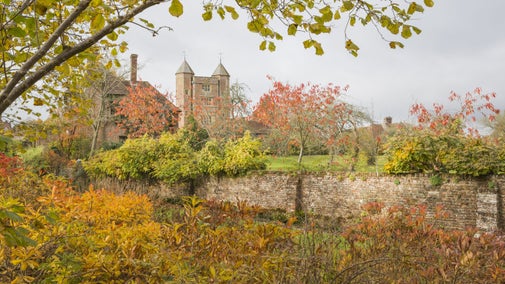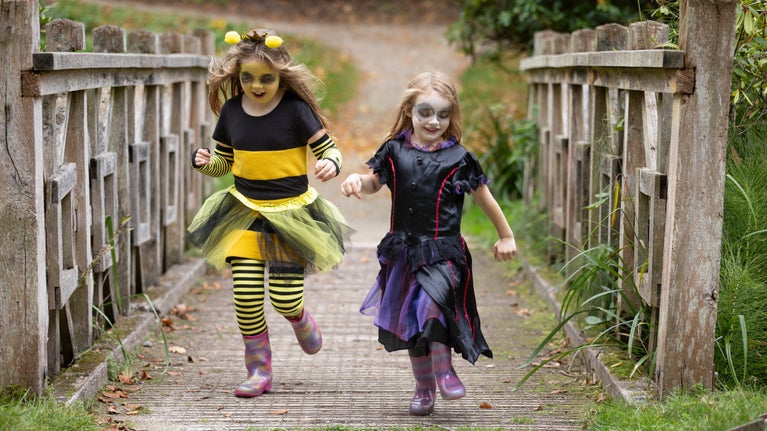
Discover more at Ightham Mote
Find out when Ightham Mote is open, how to get here, the things to see and do and more.
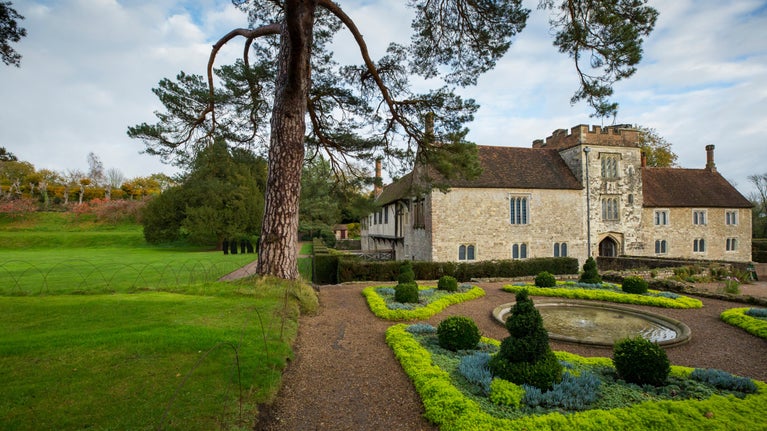
With smaller, more formal courtyard gardens, lawns and borders leading to more open, relaxed, areas of planting and woodland, Ightham Mote's garden has something ethereal about it. Each area of the garden, surrounding the four sides of the house, are connected by pathways and water. Whether it's the sunlight glistening on the moat, pools or and lakes, early morning mists, dew sparkling on spider webs, or the sound of running water from the springs, fountains or cascades, the garden has a wonderful, mysterious and tranquil atmosphere.
Make the most of the garden at Ightham Mote as we move from summer into autumn. There’s still plenty of colour and interesting things to be seen as the flowers continue to bloom.
Summer may be drawing to a close, but when you look around, you’ll still see splashes of colour. Yellow Rudbeckia with its darker central cone of florets, Anenome x hybrida, with its cup shaped pink or white flowers, adds colour whether in sun or shade.
The Hylotelephium 'Herbstfreude' and H. spectabile 'Brilliant' with their red / pink clumps of star-shaped flowers dotted along the border are a magnet for bees. Heleniums, with petals of orangey-red like ballerina’s tutus, dancing about saying ‘look at me’.
As the first days of autumn arrive, the lavender-blue flowers of Aster x frikartii 'Mönch' open, and you’ll hear the hum of bees as they gather the last of the nectar.
The apples which have been ripening on the trees in the orchard are ready to shine. Our historic apple varieties include ‘Couer de Bouef’ (13th century), ‘Nonpareil’ (1696) and ‘Flower of Kent’ (1629), which is believed to be the variety of tree Isaac Newton sat under when he was inspired to produce his laws of universal gravitation.
As summer departs, the lush green leaves of our Katsura trees, Cercidiphyllum japonicum are replaced with orange yellow hues. But they don’t just provide us with a visual delight, you may catch the smell of caramelised sugar or candy floss drifting through the air. It is this tantalising scent that gives us the trees other name ‘Toffee Apple Tree’.
The tulip tree turns an attractive golden yellow, whilst the beech leaves become a glorious orangey-brown. If it's stronger colours you're after, look out for the three different maples which turn yellow, orangey-yellow or burning red. Or the bright crimson leaves of the Euonymus, with their orange coloured berries.
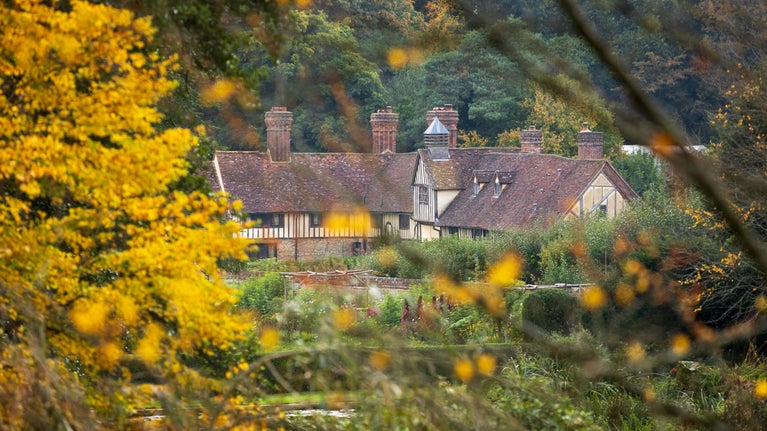
Nestled within a hidden valley, a narrow stream runs through the garden, supplying two lakes and the moat. It tumbles down two feature cascades on its journey through the grounds. Other natural springs have been tapped to supply the four small, fountain pools and several open channels, which add to the atmosphere, charm, tranquillity and variety of the garden.
If you turn left down the slope from the entrance and turn right towards the house, you arrive at the north lawn with its 18th-century cascade and terraced walks on either side. Originally the site of a lake, probably supplying fish for the household, it was drained in the 18th century to create the lawn, which features in the painting 'A Game of Bowls' by John Singer Sargent, on display in the house.
There are a variety of fish in the moat and once a year, usually on Father’s Day, fishing is allowed in the moat.
Wander around the outside of the house, past the tower, to discover the Enclosed Garden, hidden behind ragstone walls. This secluded, paved garden, with its 'secret garden' behind the hedge, provides a charming place to spend some quiet time.
Sunlight dances off the cherub fountain in the centre, while the soft colours and foliage of the planting scheme reflect the idea of the house’s American donor of what a traditional English garden should look like.
Coming out of the Enclosed Garden, the original garden and house entrance was from the driveway to your right. Imagine riding through the gates and dismounting your horse onto the mounting block to start your visit.
Today, as you walk into the stable courtyard, there are formal lawns and bright herbaceous borders. In the 17th century it was a working farm, as well as a forecourt to the house, with stables and farm buildings on three sides and a large oval carriage circle.
When the ‘new’ farmyard was built nearby in the 19th century, the remaining buildings were converted to workers' cottages and the courtyard became more ornamental with the layout of lawns and borders we see today.
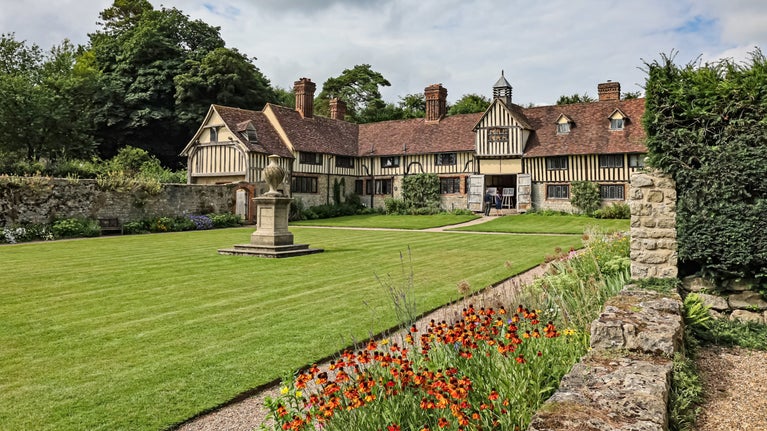
This small garden with its four symmetrical beds centred on a gently bubbling fountain and rippling saucer pool fed from a spring in the orchard, has been an Italianate Garden, and a Rose Garden in the past. Until recently it provided bedding displays, changed in Autumn and Spring each year. In response to the need for effective use of gardening time, resources and water, we have changed our approach in the last few years to a more relaxed formal style. We successfully produced bold colour schemes using annuals grown from seed and currently have a perennial display of Heuchera with different foliage colours and a succession of spring flowering bulbs.
Stepping through the high hedge, the cutting garden provides a fine display of flower and foliage shapes, colours, textures and scents from early to late summer and cut flowers for the house. Visitors can enjoy the garden from a seat or get up close using the network of paths. Lavender borders the central walk where a pergola made from willow wands provides an attractive or productive display of climbing plants.
On the other side of the orchard wall, the west terrace walk has views across the north lawn and east terraces. Now that cars are no longer parked there, removal of the screening hedge has opened the view to and from the Walled Garden, that we have not been able to see for over 100 years. The archways built using sweet chestnut from the estate feature climbing roses and the Narrow Border will continue to provide a display of spring bulbs and summer flowers.
Due to increasing difficulties in the wider, Long Border, caused by invading bindweed we are taking drastic action to try to control it over the next two years, before planting with a new mixed herbaceous and shrub scheme. The Long Border has been cleared and we will trawl through it again and then trial a sowing of Tagetes minuta that may help suppress bindweed, along with other annuals to add more colour. We will continue our efforts to control the bindweed next year and appreciate your patience, interest, and support as we work towards revitalising the Long Border.

With a meandering stream, a wildlife friendly ornamental lake, informal lawns, specimen trees, the ferny gullies of The Stumpery and The Dell, and the valley sides that blend back into the surrounding woodland the area provides a delightful, evolving mix of garden and nature.
Damming of the stream (where bridges are) to form two ponds north of the existing lake is likely to predate any gardens and the area was probably farm or woodland. Extending into the area as part of the garden has its origins in the 18th century and were extended again in the 19th century. The area became overgrown in the 20th Century and crowded with self-seeded trees. Many of these were cleared during conservation work to open the area up again to reveal the specimen trees, some of which were sadly lost during the Great Storm of 1987. The area is being managed and gradually developed with the aim of providing a balance between ornamental trees and shrubs and native species. The lake is a haven for a range of wildlife including a good population of common frogs and toads.
It's a lovely place to enjoy a gentle stroll, sit in the shade and have a picnic, take in the views or simply relax in a deckchair and listen to the sounds of birdsong and leaves rustling in the breeze.
From the north gardens, a sloping path and steps lead to the upper pathway running along the 2nd terrace of the East Bank. A planted, sunny bank rises to the 3rd terrace above, where with your support, we are in the early stages of the project to reinstate the Walled Garden.
A lower path leads to the 1st terrace of the East Bank, this is a grassed terrace with an outlook to the house and over the north lawn to the west terrace and long border. The highest section of the East Bank rises above to the upper path of the 2nd terrace, with the Walled Garden beyond. This high and long second section of the East Bank forms a significant feature within the garden. We do not know how it was planted previously but in the mid to late 19th and early 20th we know that there were shrubs within the grass banks and a beech hedge on the top bank, separating the Walled Garden from view, this hedge later grew into a line of trees. Since its donation to the Trust this section of the bank was planted with cherry trees, snowdrops, primroses and daffodils, creating a cheery display in spring with some wildflowers in summer.
Unfortunately, over the last few years there have been issues with springs, wet soil and drainage causing the cherry trees to fail and vigorous plants such as nettle, dock and hogweed to take over. However, we have been successful in applying for a garden restricted fund grant to help us to begin a project in March 2025. Over the next two years we will carry out work to improve the upper path, the drainage at the bottom of the second bank, clear problem species and sow seeds, grow on plants and establish a new planting scheme to develop the East Bank as a key feature within the garden. It will create a planting of mixed wild and ornamental herbaceous plants and grasses in a similar style to meadow and prairie planting that will provide a ‘tapestry’ of colours through the year.
A walk around the South Lake provides a wonderful view back towards the house across the lake enhanced on a bright, still day by its reflection on the water. A map from 1692 indicates a mill by the southwest edge of the lake. Like the north grounds the area was originally productive, perhaps becoming more ornamental in the 18th century and further developed as a garden in the 19th century, it also became overgrown in the early 20th century. Again, the first conservation work was to clear some of the over-crowded self-sown trees which would then allow further conservation to be carried out over the years. Sadly in recent years most of the ash trees that were saved by this work have been killed by ash dieback disease and had to be severely pruned or felled, so our conservation plans will be adapted to take account of this.
Previously only visitors on a guided tour could visit the area but since the path was built visitors can access the area around the lake on most days. Each year we do a little bit more conservation work towards its restoration as a peaceful and attractive area for a walk and a haven for wildlife. Our long-term aim is to be able to include the larger area beyond the fence, with the cascade, stream and woodland as part of the visitor experience.
Along with a few other fruits, there are more than 15 types of apples grown at Ightham Mote, most of which are heritage varieties that are not found in green grocers or supermarkets. We have apple cultivars suited for use as dessert, culinary and cider making, including the sweet tasting ‘Sunset’, first discovered in nearby Ightham Village, and the ‘Flower of Kent’, the variety beneath which Isaac Newton came up with his theory of gravity.
There have traditionally been small orchards in different locations around Ightham Mote, this one was planted in 1989. Along with the garden of Number 1 cottage and the Cutting Garden, it forms the site of what used to be the west walled kitchen garden. Each year the apples are harvested and used in the café or may be available for visitors to taste or take home for a donation.
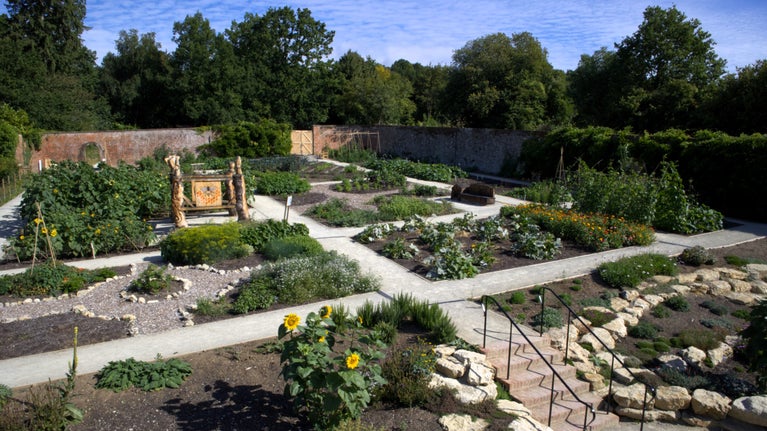
We are very excited to be getting underway with our project to reinstate a wonderful garden within the walls that, for the last 40 years, had been used as a car park. We are developing our plans, consulting our community, asking for ideas and feedback from visitors about what people would like to see in the garden and how we can make it interesting and useful to them. We want to gather people's ideas that will support and engage all our visitors and offer opportunities for them to support the development and success of our Walled Garden transformation over the next 3 to 5 years.
Our 1692 map shows that an orchard occupied the site of what became the east walled garden, it extended beyond the site northwards beside the driveway and west down toward the lake, where the North Lawn now is. The next historic map 1769, shows by that time the orchard had gone and what looks like a kitchen garden occupied the site. It may have had walls from the outset, or they may have been added a bit later and possibly modified in the 19th century. Unusually, only three sides are walled, the west side was either never, or only partially walled to take advantage of the high position offering marvellous views down over the garden and across the valley.
In their heyday both the east and west walled gardens would have provided food for the household, the walls providing shelter and warmth to grow a wider range of crops over longer periods. In the 20th century economic and other circumstances lead to changes on many estates and a decline in their gardens, many walled gardens, like ours, fell into disuse. It had become physically and visually separated from the rest of the garden as the boundary hedge grew out into beech trees. The empty space within the walls has been used for visitor car parking for the last 40 years but the recently completed Visitor Centre and car park work has removed the cars and given us a brilliant opportunity for a new project to reinstate the Walled Garden.
Walled gardens were highly productive places where knowledge, skills, ideas and innovations were shared through experience in gardens to meet the challenges and needs of their day and developed gardening through changing times. This is the approach we want to take in reinstating our Walled Garden to demonstrate elements of gardening from the past, how it has proliferated into the present, and how the challenges we face today and what we want and need from our gardens are changing now and into the future.
We hope you will support our work, take an interest in what we are doing and enjoy seeing the changes as the garden develops, ask questions, make suggestions, provide feedback or get involved in activities and events to help make the Walled Garden a success and a great place to visit.

Find out when Ightham Mote is open, how to get here, the things to see and do and more.
Enter this medieval half-timbered house across a cobbled courtyard and into the hushed interior. Discover dark wood panelling, huge fireplaces and a mix of furnishings inside.

Enjoy the sights and sounds of the season across the Ightham Mote estate.
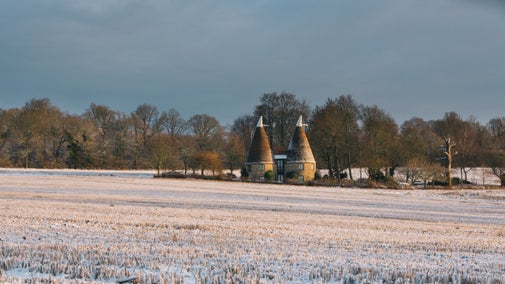
Uncover the 700-year history of this fascinating medieval house and estate. Discover all about the owners that shaped it over the centuries, their connections and lifestyles.

Pop into the Mote Café for something tasty at end of a winter walk. In the shop you can pick up a special gift, plant or homewares. Don’t forget to take a look in the two second-hand bookshops.

Ightham Mote is a two pawprint rated place. With so much space to explore your four-legged friend won’t be bored on a day out at Ightham Mote. Find out where they can go and what facilities are available on your visit.

From 18th-century water gardens and Arts and Crafts landscapes to intimate woodland gardens, there are so many places to discover.
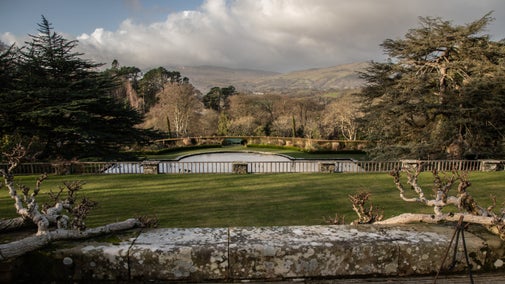
Discover our gardeners’ top tips so you can make the most of your garden, plot or window box.
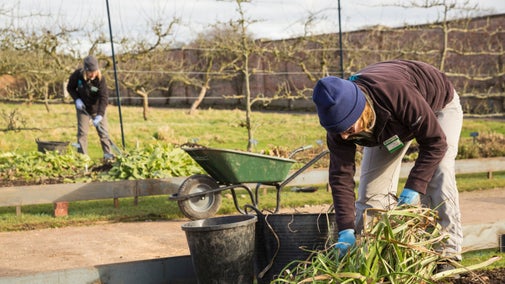
Wander through the National Trust’s autumn gardens in Kent, where golden foliage and late-season blooms create a tapestry of rich colour and texture. Admire the russet tones and crisp air at Sissinghurst Castle, stroll through the mellow hues of Chartwell’s borders, and enjoy the romantic reflections of autumn leaves in the moat at Scotney Castle. From fiery rudbeckia and amber lilies to Japanese anemones and ornamental grasses swaying in the breeze, Kent’s historic gardens offer a serene and striking celebration of the season.
